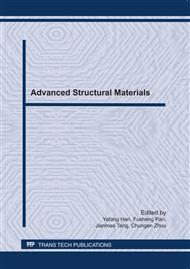p.382
p.388
p.392
p.396
p.401
p.406
p.411
p.419
p.423
Effects of Load and Sliding Distance on the Wear Properties of Hybrid Friction Materials
Abstract:
Hybrid friction materials were manufactured with glass fiber, potassium titanate whisker and aramid fiber as reinforcement and the phenolic resin modified by lumbar pericarps oil as matrix material. The effects of load and sliding distance on friction and wear properties were studied by single variable experiments. The worn surfaces of the samples were studied by Scanning Electron Microscope (SEM). The results showed that friction coefficient and wear rate can be significantly increased when the load was increased up to 250N. The friction coefficient varied between 0.25 and 0.3 while the wear rate reduced to 0.49×10-6 g/(N·m) in the sliding distance longer then 80m. Wear mechanism of samples were to be adhesive and abrasive wear.
Info:
Periodical:
Pages:
401-405
Citation:
Online since:
June 2011
Authors:
Keywords:
Price:
Сopyright:
© 2011 Trans Tech Publications Ltd. All Rights Reserved
Share:
Citation:


